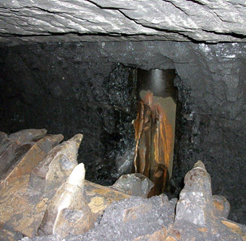Nationwide, thousands of oil and gas wells penetrate coal seams that are being actively mined. An inadvertent intersection with one of these wells could pose a hazard to miners, through the following types of interactions:
- If a mine inadvertently intersects an active gas well, methane gas can inundate the mining section.
- Abandoned wells in depleted oil and gas reservoirs can pose similar hazards because they may recharge with gas over time.
- Flooded and abandoned wells can cause injuries by forcibly ejecting material into the mine or by inundating the mining sections with water.
In recent decades, much has changed in both the mining and gas industries. Today’s coal mines are deeper, and the proliferation of high-pressure Marcellus and Utica gas wells has increased the potential consequences of an incident. New scientific information is now available, most notably downhole gas well surveys that show that depth has a big effect on the possible deviation between a well’s surface location and its location at the coal seam level. Click below to learn about best practices for development mining in the vicinity of gas wells.
Every year MSHA and state regulatory agencies evaluate approximately 1,000 requests to mine within 150 feet of oil and gas wells. Historically, the primary technical document addressing interactions between gas wells and mining in the United States has been the “Pennsylvania Joint Oil and Gas Well Gas Well Pillar Study” published in 1957. Much has changed in both the mining and gas industries since the guidelines were developed. Today’s coal mines are hundreds of feet deeper than they were then, and the proliferation of high-pressure Marcellus and Utica gas wells has increased the potential consequences of an incident. New scientific information is now available, most notably downhole gas well surveys that show that depth has a big effect on the possible deviation between a well’s surface location and its location at the coal seam level.

Well casing cut into by a continuous miner in an active coal mine.
Key Safety Practices:
The setback distance from a well should be large enough to mitigate risks associated with the cumulative impact of the following four factors: 1) Well Deviation; 2) Surveying Error; 3) Mining Error; and 4) Pillar Rib Weathering and Peak Stress Avoidance Setback.
Well deviation is the horizontal distance between the surface location of the well and where it penetrates the coal seam. Technical Support collected data from nearly 250 downhole well deviation surveys. The data shows that as wells penetrate deeper, their deviation potential increases. When the cover (H) is less than 1,000 feet, no wells had deviations greater than H times the tangent of 2°. When H is greater than 1,000 feet, the maximum deviation was less than H times the tangent of 2.5°.
Surveying error can be calculated to determine the potential location error from the closure ratio. The survey error is independent of the depth of cover.
Mining error can occur due to mining off-sights due to inadequate survey control at the face, regardless of the depth of cover. Frequently establishing sight spads and conducting check surveys mitigates risk associated with mining off-sights.
The Pillar Rib Weathering and Peak Stress Avoidance Setback addresses risks associated with a well penetrating the zone of the pillar where weathering of the rib or high pillar deformations (yield zone) occur. This setback also should prevent the well from penetrating the pillar within the region where the peak pillar stress occur, and closer to the lower-stress, more stable core.
Resources:
Best Practices – Mining Near Oil and Gas Wells
